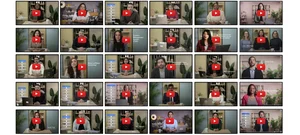How newsrooms can build new audiences through video
For the past year, I’ve led VidSpark, a Google News Initiative partnership with The Poynter Institute helping local news publishers bolster their social media video strategy. Our work aims to help newsrooms better connect with Gen Z viewers in order to maintain their relevance well into the future.
We’ve worked with three local newsrooms: GBH News, The Star Tribune and 10 Tampa Bay. These publishers have broken out of their traditional formats to spin up new social-first video series that include Gen Z voices and speak to important issues in ways that resonate with younger audiences. The three newsrooms produced a total of 98 videos through the program, publishing across YouTube, Instagram and TikTok.
I know the importance of adapting your message to social platforms in order to reach an audience. I’ve launched social-first shows with PolitiFact and PBS Digital Studios, and am also a YouTuber myself. In coaching these newsrooms, I found three lessons to be the most salient. These are key shifts in thinking for newsrooms to make in order to reach a younger, social-first audience on platforms like YouTube, Instagram and TikTok.
Create a destination, not a repository.
Think of your social account as a destination for viewers, rather than a video repository or vehicle for promotion. To build a community of younger viewers on social, create an experience within the platform that provides value and gives viewers a reason to follow and support you. To this end, GBH News created a separate YouTube channel and Instagram page specifically for the audience of their series “Internet Expert.”
Cater the content to the platform.
Incorporate features specific to each platform into your content brainstorming process in order to help people find your work. Even the most compelling videos won’t be found if they don’t have relevant thumbnail images, hashtags and other elements the platforms use to surface content. The Star Tribune began discussing thumbnail images for YouTube videos earlier in the process, which allowed producers to frame episodes around compelling questions that drove viewers to their series “Tomorrow Together.”
You need the ability to pivot.
Make your production process flexible and responsive. It’s easy to get locked into a formula, but newsrooms found the most success when they were able to adjust their style and workflow as they discovered what was most sustainable to produce and what resonated the most with their audiences. 10 Tampa Bay was nimble and made changes throughout the process. Reporter Jenna Bourne evolved out of her broadcast persona to a more casual delivery style in how she presented and filmed her series “What’s Brewing?” for a YouTube audience.
We go into these topics and others in the VidSpark Playbook, a guide to help newsrooms create and refine their video strategy for social media.
The playbook includes guidance for thinking about content development, best practices for various social platforms and case studies for the three local newsrooms we worked with this past year. We explain the newsrooms’ development processes, workflows and how they’re building social-first video into their content going forward.
We know that building content in a format that resonates with younger audiences is critical for local news publishers, but it isn't easy. That being said, the newsrooms we worked with proved that it is possible with a dedicated team and a willingness to experiment.
You can find our playbook along with more information about VidSpark at Poynter.org/VidSpark. Feel free to reach out with any questions at info@poynter.org.






